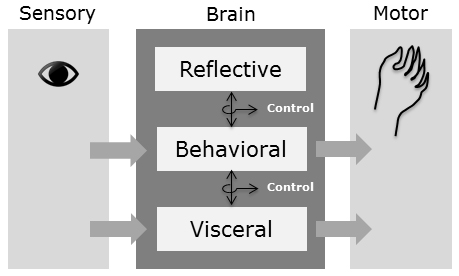This model was established by Norman (2004) and his colleagues, Andrew Ortony and William Revelle. This model explains how emotion and behavior are determined by different level of the brain. According to this model there are three levels of brain organizations which are related to emotion regulation (Figure 4). First level is known as visceral level which is associated with immediate communication in response to change in surrounding environment. Second level involves in regulation/control of our everyday behavior and this level is known as behavioral level. At the highest level, brain further processes and anticipates the signals of behavioral level. This level is called reflective level.
According to this emotion model visceral level responds rapidly, making judgments about what is good or bad, safe or dangerous, pleasurable or disgusting etc. It also triggered different emotional responses to stimuli, such as fear, joy, anger and sadness that are combination of physiological and behavioral responses. For example if someone seeing a large hairy spider in the bathroom most people will experience fear and causing the spider to run away or run away. The behavioral level is the site where most human activities occur. In reflective level people decides how to control emotion and how to respond further towards the stimulus.

Figure 4. Emotional design model (Adapted from Norman, 2004)
Several claims have been made base on this model e.g. how we respond to stressful or pleasurable situations. The central claim of this model is that our affective state, be it positive or negative depends on how we think about the situation. For example when we are angry, the emotional response is to focus on the problem at hand and try to resolve the perceived danger. In such situation, our bodies will respond by tensing our muscles and sweating. On the other when we are happy when our favorite team won a cricket match, the emotional response is to lough, cheer, and jump about. Our body relaxes in such moments.
One interesting claim of this model is that when people are happy they are more likely to overlook and cope with minor problems they are experiencing with many devices (Norman, 2004). On contrary, when a person is anxious or angry they are more likely to be less tolerant.
Following this above discussions few questions are raised regarding application of this theory in product design:
- Do designers create products according to different emotional states of the users/consumers?
- If, yes, then ‘Is this kind of product thinking realistic?’
Answer of these questions is ‘No’, because in real life situations, development of this kind of adaptive products is not realistic. Instead, Norman’s model is applicable in another way i.e. context specific design practice. Norman argues that if the product is intended to be used during leisure time and is moment of fun and enjoyable to use then designers need not to worry about how much attention is paid to the information coming in the interface or what kind of information is coming in the interface. On the other hand, he argued that for serious task e.g. in case of car driving, designers need to pay attention to all information required to do task at hand and that the interface should be visible with clear and unambiguous feedback.
Less controversial application of this model is how to design products in terms of the three levels. For example, visceral design refers to making products look, feel and sound good. Designers can use aesthetic techniques to make product emotional e.g. designers may use clean lines, balance, colour, shapes and texture. Table 4 will also be helpful for designers to develop emotional products through understanding of different emotional states/ affects related to different human senses.
Table 4. Affects are associated with different senses (Adapted from Norman, 2004)
|
Affect |
Positive |
Negative |
|
Value |
Pleasant |
Unpleasant |
|
Visual |
Smiling faces |
Frowning disgusted faces |
|
Touch |
Rounded objects |
Sharp objects |
|
Hearing |
Soothing/ harmonious sounds |
Harsh/ discordant sound |
|
Smell |
Sweet smells |
Smell of spoiled egg |
|
Taste |
Sweet taste |
Bitter taste |
Positive and negative affects

